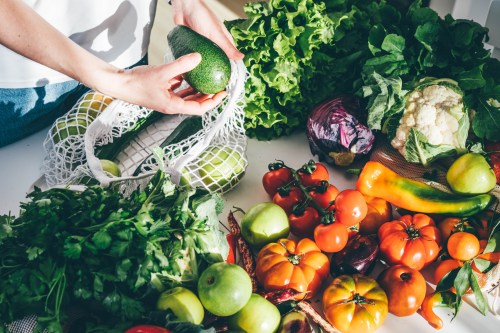A Mixologist and Registered Dietitian Answer an Age-Old Question: What Are Bitters?
Get an answer to the age-old question: What are bitters? Plus, learn why you'll want to use them for cooking, not just making cocktails.

Here’s a riddle for you: What do old fashioneds, Manhattans, Aperol spritzes, and negronis all have in common—other than being alcoholic cocktails, of course? The answer? Bitters. “Through a bitter, you can bring a lot of different flavors to a cocktail, which helps elevate them to have more complexity and more dimensions than they would have with just spirits, sugar, or sodas,” says Brian Cummins, a chemical engineer, mixologist, and the founder of Great Northern Distilling in Stevens Point, Wisconsin.
Experts in This Article
chemical engineer, mixologist, and the founder of Great Northern Distilling
anti-diet dietitian based in Philadelphia, Pennsylvania
Similar to how chefs season meats and veggies with salt, pepper, and other spices, mixologists use bitters to “season” beverages. However, while bitters are most often found on a bar, there are myriad ways to use them in cooking, not just cocktails. A prime example of this is vanilla extract. Whether you use it in a drink or dessert, the extract imparts a rich and aromatic vanilla flavor to enhance the taste.
But what are bitters?
Simply put: “Bitters are concentrated herbal or botanical extracts that are used to add flavor,” says registered dietitian Dalina Soto, RD, LDN, founder of Nutritiously Yours and Your Latina Nutritionist. She adds that they have a long history in Indigenous cultures across Latin America—like Venezuela and the Dominican Republic. (For example, Angostura bitters, named after a former Venezuelan town, are extremely common in the mixology world and found in both the classic cocktails old fashioned and Manhattan.) “They were initially developed for medicinal purposes, but over time, they have been used in food [and beverages],” she says.
This is primarily because bitters, in addition to providing flavor, may offer potential digestive benefits by stimulating the production of digestive enzymes and saliva, promoting smoother digestion, and alleviating feelings of bloating.
There are two different ways to make bitters, according to Cummins. “Technically, most are tinctures—meaning that the flavors are extracted with alcohol,” he says. “Essentially, you put whatever combination of herbs and spices into a high-proof alcohol solution. This extracts all those flavors and essential oils out of the spices over time to create the tincture.”
As you may have guessed, tinctures are alcoholic. Now, you can also have bitters in the form of extracts, which is done using any solution to draw out the flavors—alcoholic or otherwise. “All tinctures are extracts, but not all extracts are tinctures,” Cummins explains. Extracts—like vanilla, almond, or peppermint—are created by using any liquid to draw out the flavors. “From a chemical standpoint, an extract can be made with water, glycerin, non-alcoholic solutions, and alcoholic solutions,” says Cummins. Non-alcoholic solutions could be vinegar or oils, like olive oil.
Just like there are two different ways to make bitters, there are also two different classifications: cocktail and digestive. Per Cummins, the distinction between cocktail bitters and digestive bitters is a governmental classification. “Cocktail bitters, according to the Alcohol and Tobacco Tax and Trade Bureau, are non-potable—meaning they’re not intended to be drunk on their own,” he says. For that reason, they’re not taxed like or sold with regular spirits, Cummins adds. These are things like vanilla or citrus extracts.
In the context of this classification, cocktail bitters, which are often used as flavor enhancers in mixed drinks, fall under the non-potable category. They are not meant to be consumed undiluted due to their concentrated and intense flavor profiles. This distinction allows them to be exempt from certain regulations and taxes that apply to regular spirits.
Conversely, digestive bitters are alcoholic drinks made from tinctures. Think Aperol or Campari. “They are more in the European, specifically Italian, tradition of bitter liquors that are used either as an aperitif, which is drunk before a meal, or a digestif, which is a post-dinner drink,” says Cummins. “Digestive bitters will typically include a high amount of sugar to make it more palatable.”
It’s worth noting that while this is a regulatory classification, consumers often use both cocktail and digestive bitters in various ways, and the distinction is primarily for administrative and tax purposes.
Regardless of what type of bitters you choose, what’s important to remember is that you can use them in a multitude of ways just like any spice or seasoning since their primary purpose is to add flavors. However, unless you’re a mixologist or master home chef, just starting to add a dash of bitters here or there isn’t the best way to go about utilizing them. “Ideally, you would want to learn about them and their flavor profile and utilize them in dishes you think they fit,” Soto says. For instance, if you want something to taste like cloves or cinnamon, Angostura bitters are your go-to. On the other hand, for a citrus-forward dish or drink, you may want to grab a bottle of orange bitters. Bottom line: Don’t relegate bitters to just your bar cart—bring them into your kitchen too.
Sign Up for Our Daily Newsletter
Get all the latest in wellness, trends, food, fitness, beauty, and more delivered right to your inbox.
Got it, you've been added to our email list.










